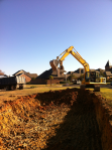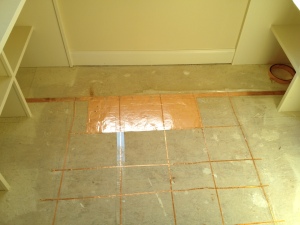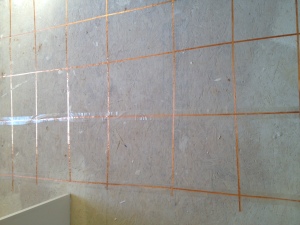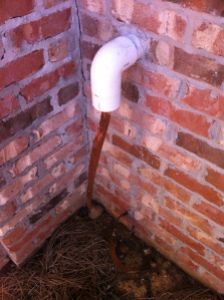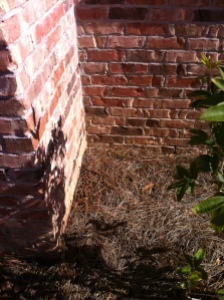Being on the 2nd floor, I was especially concerned about an RF ground. I read and re-read a lot of the current websites on RF grounds, saw folks call one another names, and figured I was going to be out of luck! To make it worse, the builder and electrical contractor had placed my electric service panel where the local code required it: nearest point of entry to the extant buried service point. Unfortunately, this was on the opposite of the house from my shack. No nice tying everything into the service ground as all of my sources insisted was needed. With brick, concrete, and landscaping, there was no way (after the fact) to run a buried ground cable down to the point under my ham shack.
The soil where we built is commonly referred to as Mississippi Gumbo, or Yazoo Clay. Not great for stable, sturdy, and long-term structures being built on it. But hopefully not bad as far as ground conductivity. I’m still searching for a more precise measurement of that for Yazoo Clay. It does tend to stay moist but some Kitty Litter and watering the Hydrangea plant in front of the PVC pipe may help.
At the same time, there are a lot of hams who’ve operated successfully without explicit RF grounds. One is Steve Katz WB2WIK. See his QRZed posts or his appearance on Ham Nation. On the other hand, Tom W8JI, has a masterful website and he operates a contest station on the 2nd floor of a converted barn. Hmm…surely I could come up with something that made sense and would help keep RF out in the ether instead of my lips at the mic or my alarm system or in my neighbor’s stereo.
W8JI’s site shows a grid laid down on the 2nd floor. He suggests copper, of course, and further says that the grid with a pattern of smaller than 2’x2′ doesn’t make much of a difference. I checked Georgia Copper and a host of other copper mesh suppliers so that I could perhaps put a layer of copper mesh down on top of the plywood sub-flooring before the carpet went down. That would have cost about $600! Tom W8JI made a comment about thin copper strips from a hobby store. A trip with my wife to a nearby Hobby Lobby and I was ready to start with the grid! I laid down a 2″ copper strap on the floor to connect a common ground between both sets of built-in cabinets. From this copper strap, the thin copper adhesive strips from the hobby store were run so that the desired 2’x2′ grid pattern emerged on the sub-flooring. These were all soldered where ever the copper strip connected to another or to the copper connecting strap.
As a humorous aside, the carpenters installing cabinets in the adjacent bathroom had bets on what the hell was going down on the floor in my office. They thought I was another sub-contractor installing a heated floor but what idiot would get a heated floor in Mississippi! To a person, they all gathered to watch as I explained what I was doing and why I was doing it. They said they don’t see that every day in the houses they help build!
The PVC pipe that ran from the attic above my shack contained a T-connector for coax and control wire to enter under a shelf on the cabinet. It continued and made an elbow turn to outside the house near the ground. I put three ground rods several feet apart into the Yazoo Clay and connected each one by the 2″ copper strap as shown below. Following W8JI, I connected a master bus under one of the shack cabinet shelves next to the incoming PVC elbow with the outside ground strap and the inside false ground grid to a common ground bus. All of my powered equipment is connected to this ground bus using tinned copper braid ground strap material.
On the left picture, you can see the exiting copper strap—I’ll paint the white PVC to a rust color to please the XYL—and the right picture is the final ground rod. There is one more to the right of the one beneath the PVC pipe next to the brick chimney not shown in the two pictures.
George W5JDX, host of Smoke and Solder on Ham Nation and co-host of Amateur Logic TV, said he’d wager that this would solve my ground problem as the potential for the ground strap inside the descending PVC to the ground was less than 10 feet. Thus far, and as far as I can tell, he’s right!
I have an MFJ-931 Artificial Ground device that Martin Jue sells. It it great for portable operations where radials aren’t very easy to lay down. But it’s also a good tool to “see” the differential between what is expected in ground impedance and what is present. I may experiment with this notion to see how the false ground under the carpet operates vs. the strap to the three ground rods outside. For the time being, I’m just glad to feel like I’ve done what I could do with what I have to play with.

